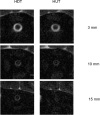Posture-Dependent Collapse of the Optic Nerve Subarachnoid Space: A Combined MRI and Modeling Study
- PMID: 33877263
- PMCID: PMC8083083
- DOI: 10.1167/iovs.62.4.26
Posture-Dependent Collapse of the Optic Nerve Subarachnoid Space: A Combined MRI and Modeling Study
Abstract
Purpose: We hypothesize that a collapse of the optic nerve subarachnoid space (ONSAS) in the upright posture may protect the eyes from large translamina cribrosa pressure differences (TLCPD) believed to play a role in various optic nerve diseases (e.g., glaucoma). In this study, we combined magnetic resonance imaging (MRI) and mathematical modeling to investigate this potential ONSAS collapse and its effects on the TLCPD.
Methods: First, we performed MRI on six healthy volunteers in 6° head-down tilt (HDT) and 13° head-up tilt (HUT) to assess changes in ONSAS volume (measured from the eye to the optic canal) with changes in posture. The volume change reflects optic nerve sheath (ONS) distensibility. Second, we used the MRI data and mathematical modeling to simulate ONSAS pressure and the potential ONSAS collapse in a 90° upright posture.
Results: The MRI showed a 33% decrease in ONSAS volume from the HDT to HUT (P < 0.001). In the upright posture, the simulations predicted an ONSAS collapse 25 mm behind lamina cribrosa, disrupting the pressure communication between the ONSAS and the intracranial subarachnoid space. The collapse reduced the simulated postural increase in TLCPD by roughly 1 mm Hg, although this reduction was highly sensitive to ONS distensibility, varying between 0 and 4.8 mm Hg when varying the distensibility by ± 1 SD.
Conclusions: The ONSAS volume along the optic nerve is posture dependent. The simulations supported the hypothesized ONSAS collapse in the upright posture and showed that even small changes in ONS stiffness/distensibility may affect the TLCPD.
Conflict of interest statement
Disclosure:
Figures








Comment in
-
Posture-Dependent Collapse of the Optic Nerve Subarachnoid Space: A Combined MRI and Modeling Study.Invest Ophthalmol Vis Sci. 2021 Dec 1;62(15):16. doi: 10.1167/iovs.62.15.16. Invest Ophthalmol Vis Sci. 2021. PMID: 34932064 Free PMC article. No abstract available.
-
Author Response: Posture-Dependent Collapse of the Optic Nerve Subarachnoid Space: A Combined MRI and Modeling Study.Invest Ophthalmol Vis Sci. 2021 Dec 1;62(15):15. doi: 10.1167/iovs.62.15.15. Invest Ophthalmol Vis Sci. 2021. PMID: 34932065 Free PMC article. No abstract available.
Similar articles
-
Optic Nerve Subarachnoid Space Posture Dependency - An MRI Study in Subjects With Normal Tension Glaucoma and Healthy Controls.Invest Ophthalmol Vis Sci. 2023 Dec 1;64(15):20. doi: 10.1167/iovs.64.15.20. Invest Ophthalmol Vis Sci. 2023. PMID: 38099734 Free PMC article. Clinical Trial.
-
Mathematical modelling of the CSF system: effects of microstructures and posture on optic nerve subarachnoid space dynamics.Fluids Barriers CNS. 2022 Aug 30;19(1):67. doi: 10.1186/s12987-022-00366-4. Fluids Barriers CNS. 2022. PMID: 36042452 Free PMC article.
-
Intracranial and Intraocular Pressure at the Lamina Cribrosa: Gradient Effects.Curr Neurol Neurosci Rep. 2018 Apr 12;18(5):25. doi: 10.1007/s11910-018-0831-9. Curr Neurol Neurosci Rep. 2018. PMID: 29651628 Free PMC article. Review.
-
Which compartments of the optic nerve and its sheath are associated with intracranial pressure? An exploratory study.J Neuroimaging. 2024 Sep-Oct;34(5):572-580. doi: 10.1111/jon.13224. Epub 2024 Jul 21. J Neuroimaging. 2024. PMID: 39034603
-
Current concepts of cerebrospinal fluid dynamics and the translaminar cribrosa pressure gradient: a paradigm of optic disk disease.Surv Ophthalmol. 2020 Jan-Feb;65(1):48-66. doi: 10.1016/j.survophthal.2019.08.005. Epub 2019 Aug 23. Surv Ophthalmol. 2020. PMID: 31449832 Review.
Cited by
-
Diameters of the optic sheath and superior ophthalmic vein can expand and contract at positional changes: a magnetic resonance imaging study.Surg Radiol Anat. 2024 Feb;46(2):153-158. doi: 10.1007/s00276-023-03281-x. Epub 2024 Jan 8. Surg Radiol Anat. 2024. PMID: 38189913
-
Optic Nerve Subarachnoid Space Posture Dependency - An MRI Study in Subjects With Normal Tension Glaucoma and Healthy Controls.Invest Ophthalmol Vis Sci. 2023 Dec 1;64(15):20. doi: 10.1167/iovs.64.15.20. Invest Ophthalmol Vis Sci. 2023. PMID: 38099734 Free PMC article. Clinical Trial.
-
Author Response: Posture-Dependent Collapse of the Optic Nerve Subarachnoid Space: A Combined MRI and Modeling Study.Invest Ophthalmol Vis Sci. 2021 Dec 1;62(15):15. doi: 10.1167/iovs.62.15.15. Invest Ophthalmol Vis Sci. 2021. PMID: 34932065 Free PMC article. No abstract available.
-
Posture-Dependent Collapse of the Optic Nerve Subarachnoid Space: A Combined MRI and Modeling Study.Invest Ophthalmol Vis Sci. 2021 Dec 1;62(15):16. doi: 10.1167/iovs.62.15.16. Invest Ophthalmol Vis Sci. 2021. PMID: 34932064 Free PMC article. No abstract available.
-
Effects of head-down tilt on optic nerve sheath diameter in healthy subjects.Ophthalmic Physiol Opt. 2023 Nov;43(6):1531-1539. doi: 10.1111/opo.13200. Epub 2023 Jul 3. Ophthalmic Physiol Opt. 2023. PMID: 37401194 Free PMC article.
References
-
- Ren R, Jonas JB, Tian G, et al. .. Cerebrospinal fluid pressure in glaucoma: a prospective study. Ophthalmology. 2010; 117: 259–266. - PubMed
-
- Lindén C, Qvarlander S, Jóhannesson G, et al. .. Normal-tension glaucoma has normal intracranial pressure: a prospective study of intracranial pressure and intraocular pressure in different body positions. Ophthalmology. 2018; 125: 361–368. - PubMed
-
- Guy AH, Wiggs JL, Turalba A, Pasquale LR.. Translating the low translaminar cribrosa pressure gradient hypothesis into the clinical care of glaucoma. Semin Ophthalmol. 2016; 31: 131–139. - PubMed
Publication types
MeSH terms
LinkOut - more resources
Full Text Sources
Other Literature Sources
Medical

